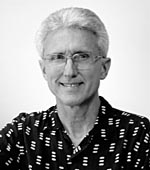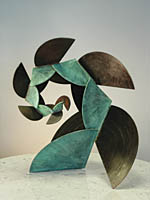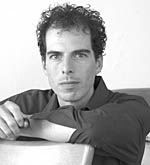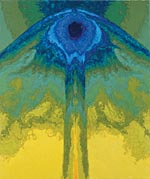The Synergy of Art and Science on Display at New AAAS Exhibit
 Craig Schaffer
|
The AAAS Art of Science and Technology Program opens its latest exhibit on 15 September with a reception for the two featured artists: sculptor Craig Schaffer and painter Jonathan Feldschuh. Their works illustrate the idea that, instead of being polar opposites as many believe, art and science share much common ground.
Schaffer sees art and science as emerging from the same principles. "Artists and scientists have long observed that the inherent properties of units and the rules that govern growth and interaction create distinctive patterns at all levels of organization," he writes. "The laws by which process produces pattern—and which help define what life is—are more basic than life itself and pervade every aspect of existence."
His sculptures attempt to reflect this idea. The undulating lines of "A Rose Is..." and the angular planes of "Explosive Growth," for example, both emulate life and growth. "The shapes that are created by complex processes, and that repeat with variation from small scales to large, are commonly referred to as fractals," he writes. "Because of the non-linear, reflective nature of real life, these processes tend to follow spiral paths. Although my sculptures do not illustrate any specific phenomenon, they all contain spirals that grow in the same reflexive manner as real complex systems."
The influence of science on Feldschuh's art is even more apparent. He was a junior at Harvard studying physics under the distinguished Howard Georgi when he realized physics wasn't right for him. His adviser was flabbergasted when Feldschuh told him that, despite graduating summa cum laude, he wanted to set aside physics to pursue art and abstract painting.
But his art remains heavily influenced by his background in science. "I began to use iconic scientific images as a starting point for paintings, mostly images from the Hubble Space Telescope and other orbital observatories," he said. People would be able to see the images from across the room and recognize them as iconic images, but up close the paintings' surfaces hold the most interest.
Feldschuh uses multiple layers of acrylic, which gives the surface a smooth, glossy finish and adds depth. "In between these smooth, clear layers, I work with various media, including pencil, pen and dispersed pigments mixed in more acrylic medium," he says in a statement on his website. "Close inspection of a painting will reveal the structure of the layers, which do not necessarily follow the pictorial layering (e.g. the 'foreground' of the image is often on one of the deepest layers, whereas the 'background' is often one of the last layers painted.)"
AAAS is displaying the works by Schaffer and Feldschuh now through 28 October 2005 as part of the AAAS Art of Science and Technology Program, established in 1985 to present science-related art of all kinds. The program's goal is to display work that reflects the centuries-old interaction of art and science. Exhibitions span the range of scientific inquiry. An opening reception will be held on Thursday, 15 September 2005, from 5:00 to 7:00 p.m.
The AAAS building is located on the northwest corner of 12th and H Streets in Washington, D.C. Exhibit viewing hours are Monday through Friday, 9 a.m. to 5 p.m. For more information, please contact Virginia Stern at vstern@aaas.org or 202-326-6672 or Shirley Koller, curator for the Schaffer and Feldschuh exhibit, at 202-333-4817.
Kelly Gayden Osborn and Lonnie Shekhtman
6 September 2005
(c) 2005 AAAS
|
Read all available reviews: |
|


